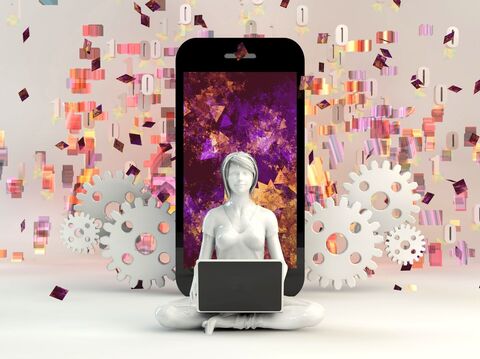What is Gamification?

Gamification means adding fun game-like features to things that aren’t games—like apps, websites, or even shopping. It could be something as simple as earning points, unlocking badges, completing challenges, or seeing your name on a leaderboard. These small features make people feel more excited and motivated to act.
You might have seen this in apps like Duolingo, where you get rewards for learning every day, or in coffee shops that give you points for every order. It’s a smart way to keep users interested and coming back more often.
Innovative Ways to Engage Customers Through Gamification
Keeping your customers engaged is necessary to growing a successful business, but it's not always easy. You’ve to get creative in finding ways to grab their attention and keep them interested in what you offer. It might mean trying new tactics or listening more closely to what they really need.
One powerful solution that many businesses are now exploring is gamification. By adding game-like elements to your website, you can increase interaction, build loyalty, and drive customer engagement.
Gamification taps into people's natural desires for competition, achievement, and rewards. Whether through point systems, challenges, or leaderboards, gamification tools can transform your customers’ experience.
Let’s explore how it works!
Gamification Techniques to Boost Customer Engagement
Below, we’ve listed some proven gamification techniques. These strategies can help you keep customers engaged, motivated, and excited to return:
-
Rewards Systems
Rewarding customers is one of the most effective ways to enhance your sales. Rewards create excitement among users and encourage them to take more actions.
For utilising this strategy, you can offer customers points, discounts, or exclusive products for completing certain actions, such as signing up, sharing content, or making a purchase. Starbucks has also been using a rewards system. It lets customers earn stars with every purchase, which can later be traded for free drinks, snacks, or other benefits.
Such techniques work because they make customers feel like they are making progress. People enjoy reaching goals, and these rewards push them to keep going. When customers feel like they are achieving something, it strengthens their connection with your brand and builds loyalty.
-
Challenges
Introducing challenges into your customer experience is a great way to keep them actively engaged. Challenges add a sense of accomplishment and fun, encouraging customers to interact more with your brand.
By setting up small challenges, you can motivate your customers to participate more often. For example, daily or weekly tasks like completing a quiz or a workout routine can keep them coming back. These challenges give customers a reason to stay involved and make progress.
-
Leaderboards
Leaderboards are a great way to add excitement to your gamification strategy. People enjoy seeing how they rank against others, which fuels their competitive spirit. By showing them where they stand, leaderboards motivate users to stay active and keep participating. This keeps your app or website engaging and fun.
Their most significant attraction is that they highlight top performers. By showcasing the best users, you encourage other customers to push themselves harder and participate more often. As users see their rank improving, they feel a sense of achievement and remain engaged with your brand.
A good example of leaderboards is Strava, a fitness app for runners and cyclists. Strava has leaderboards that rank users based on their performance, like how far or how fast they run or cycle.
For instance, if someone runs a specific route, they can see how they compare to others who have done the same route. This encourages users to improve their performance to move up the rankings. The leaderboard motivates people to beat their best times, making them active users.
-
Levels and Badges
Levels and badges offer customers a recognition for progress, thus encouraging them to participate.
By introducing levels and badges, you can make small accomplishments can feel more meaningful for your customers. For example, when users hit certain milestones, they unlock a new level or earn a badge. This simple recognition makes them feel like they’re progressing- thus building a connection with your brand.
Moreover, levels and badges build stronger ties with users over time. They reward long-term engagement, making users feel valued for their efforts. When people feel appreciated, they are more likely to stay loyal to your brand and engage repeatedly.
Tips for Implementing Gamification Strategies
Gamification can be a step towards your digital transformation, and so, it requires thoughtful planning and execution. Here's how you can implement gamification strategies to maximise customer engagement:
-
Know Your Audience
Understand what motivates your customers. Some like competition, while others enjoy earning rewards or social recognition. Match your gamification to their interests. When the experience feels right for them, they’ll want to engage more with your brand.
-
Start Small and Scale Up
Start with easy gamification, like points or badges, and see how people respond. If they like it, add more features like challenges or leaderboards. Build slowly so it’s not too much at once. This helps you adjust as you go.
-
Integrate Gamification with Your Core Product
Make sure the gamification tools fit into your product naturally. It should feel like part of the overall experience, not separate. For example, a fitness app might use rewards to motivate more exercise. Keep it simple and aligned with your product’s goal.
-
Measure Success
Use social media metrics and tools to check how well gamification is working. Look at metrics like how often customers engage and return. See which features work best and change what’s not helping, to stay updated!
Case Studies: How Top Industries Used Gamification to Drive Customer Engagement?
Gamification has really taken off in various industries, boosting customer engagement in unique ways.
From retail to fitness, businesses are finding creative ways to make their services more interactive and fun for their customers. Let’s get on with some real-world examples where gamification is making a big impact across different sectors:
1. Retail Industry: Nike
Nike’s Run Club app keeps customers engaged through gamification, allowing them to track progress and set personal goals. It also allows them to take part in challenges that push them to run more. Users can share their achievements with friends, making the experience more social and fun.
This approach makes running feel like a game. Users are motivated to improve and hit new goals. They feel proud when they complete a challenge or reach a milestone. By making fitness more enjoyable, Nike has created a community of loyal users who feel connected to the brand.
2. Education Industry: Duolingo
Duolingo turns language learning into a game with levels, badges, and leaderboards to keep users engaged.
As learners finish lessons, they earn points and badges, which shows their progress and encourages them to do more. The leaderboards let them see how they compare to others, adding friendly competition.
Every day, Duolingo offers new challenges to keep users coming back. Challenges like these keep you practising and hitting new goals, helping you stay focused and continue learning.
By turning lessons into a game, Duolingo makes hard tasks, like learning new words, more fun. Users feel rewarded for their effort, so they stay motivated. This is why millions of people use Duolingo daily, and why the app has so many loyal learners.
3. Finance Industry: Monzo
Monzo is a UK bank that lets users set savings goals, like saving for a holiday or a new gadget. When they reach their goals, the app rewards them with notifications and small celebrations. This makes users feel proud of their progress.
Monzo’s app also tracks spending, helping people see how much they save each week or month.
By using gamification, Monzo has made finance more engaging. People use the app more often to check their savings, set new goals, and track their money. This keeps them involved and interested in managing their finances.
Monzo’s approach makes saving and budgeting feel like a personal challenge that’s easy to stick with.
Wrapping Up: Gamification Customer Engagement
Gamification is a tested way to drive customer engagement and build loyalty. By using rewards, leaderboards, challenges, and badges, you can turn routine customer interactions into deeply engaging experiences. When thoughtfully implemented, it’s an effective tool that can keep your customers coming back for more.
These gamifications to increase engagement are already transforming industries like retail, education, finance, and fitness, and can also help you become the next trailblazer in your industry!
Take the plunge now and start using gamification techniques to accelerate your brand's growth. Partner with GrowthJockey today to explore which gamification strategies can fit your needs perfectly!
Gamification FAQs
1. What are some unique gamification features to engage customers?
Use features like virtual scavenger hunts or unlockable rewards to make things more fun and boost customer engagement through challenges. Adding these to your gamification website helps keep people interested and connected to your brand.
2. How is gamification different for services and products?
If you offer services, reward quick responses or excellent service to keep customers engaged. If you sell products, celebrate frequent use, or when customers share them with others. Gamification works for both services and products, helping to encourage repeat business and loyalty.
3. What are the risks of using gamification?
The risk is established when using too much gamification. Too many games can feel forced and confuse customers. Make sure your gamification tools match your brand’s purpose. Gamification should build a connection, not overwhelm people. Keeping things simple helps customers stay engaged.
4. Does gamification increase engagement?
It sure does! When you make something more fun and rewarding, people naturally want to stick around. That’s exactly what gamification does—it adds a layer of excitement through things like points, badges, or challenges. Instead of just using a product or service, customers feel like they’re part of a game where their actions count.
This keeps them coming back, spending more time, and building a stronger connection with the brand. So yes, gamification can seriously boost engagement when done right.








